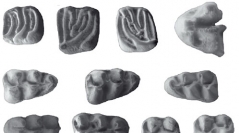

 Geodiversitas
32 (3) - Pages 501-513
Geodiversitas
32 (3) - Pages 501-513The fossil mammal bearing localities Blanquatère 3 (Roussillon; filling of a fissure in a karst) and Puisserguier (Languedoc; brackish to lake deposit) have provided Middle Miocene rodents that first allow correlating these sites to Blanquatère 1 (Roussillon; older) and La Grenatière (Languedoc; younger). Second, the occurrence of the genus Cricetodon in these newly discovered localities similarly allow revisiting the correlations already proposed with the well-known localities from the Lyon area, Vieux-Collonges and La Grive. Blanquatère 3 and Puisserguier are older than La Grive, and Blanquatère 3 is slightly older than Vieux-Collonges. The fossil bearing levels of Puisserguier is interstratified in a mainly marine succession ending with brackish to lake deposits, which includes the level of La Grenatière. The onshore (Western Béziers area) and off shore (Tramontane 1 drilling) data on the marine Miocene agree referring these deposits to the Serravallian stage, the uppermost marine levels belonging to zone NN9 (drill) and NN6 (onshore), the uppermost brackish to lake deposits cannot be younger that the Miocene deposits encountered by the drill. According to the new collected data on one side, and the Miocene chronostratigraphy, it can be hypothesized that Blanquatère 3 is c. 15.5 Myr old and Puisserguier, c. 14 Myr.
Mammalia, Rodentia, Middle Miocene, southern France, correlations, biostratigraphy